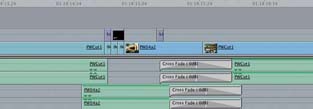Hack 43. Create a Submaster for Editing
| < Day Day Up > |
|
easily manage a project. Submastering helps editors deal with these situations. Whether you are dealing with a small project or a large one, changes are an inevitable result of the editing process. As you are editing, the more changes you make, the more your mind begins to swirl. This is especially true when your changes are being influenced by a third party, such as a director or producer. By creating a submaster, you will limit the number of tapes you need to handle over time.
When you're dealing with a lot of footage, that's a perfect time to create a submaster. You can create a timeline and go through your footage to locate selects (i.e., footage that you know you want to use). You should not be editing this footage into anything really meaningful, but rather grabbing the footage you find you will use in your final timeline.
When you have created a timeline that contains enough footage to fill a tape, you can output and create your submaster. After creating your submaster, you can then create a new timeline and continue the selection process. You should not delete your timeline, as it is a reference to where your footage originated. 4.6.1. Creating a SubmasterThe process of creating a submaster is the same as the process of creating a master tape. Once you have assembled your timeline, simply output it to tape.
The result is a tape you can use to edit with in the future. Keeping a copy of your project that relates to the tape you have created is a good process. In other words, save a copy of your editing project immediately after outputting to tape. If you want to continue to work on the project after outputting your submaster, you should work on a copy of the saved project. Otherwise, if you continue to work on the project, you will lose any references you may need at a later date. This is an essential step and a good habit to get into, even if you are not using the submaster process. 4.6.2. Using a SubmasterYou use a submaster exactly as you use master tapes. A submaster effectively becomes a master tape within your project. The only difference is that it is a compilation of footage from various master tapes. When using a submaster, what is most important is that you can distinguish it from your other tapes. You should make sure your tape-numbering scheme allows for you to make the required distinction. A simple number like PWCut1, representing Peter's Wedding Cut #1, works quite well. Figure 4-13 shows a timeline utilizing a submaster. Figure 4-13. A submaster, PWCut1, being used in a timeline If you have created a submaster from an edited project, you can create a new timeline, digitize the submaster, and then cut into the submaster. By doing this, you will have a much cleaner timeline and, if your system has been slowing down (i.e., dropping frames), possibly allow your system to perform better. The performance improvement will occur because your hard drive will not have to jump around so much to play a lot of different files. |
| < Day Day Up > |
EAN: 2147483647
Pages: 158


 Digital Cut
Digital Cut